David's Astronomy Pages (Solar System)
|
Planets |
Home Page |
Stars |
|

Comets This page summarises observations and images of comets and meteors. For a listing of all Comet and Meteor Images see Image Database - Comets
- Hyakutake - Hale Bopp - C/2000 WM1 - C/2000 SV74 - C/2004 Q2 (Machholz) - C/2004 Q2 (Machholz) - Comet 73/P Schwassmann-Wachmann 3-C 
Meteors - Perseid Meteors (1995-Aug-12) - Leonid Meteors (1998-Nov-17) - Leonid Meteors (1999-Nov-17/18) - Geminid Meteors (1999-Dec-12) - Quadrantid Meteors (2000-Jan-3/4) - Leonid Meteors (2000-Nov-17)
I've seen 2 naked eye comets - Hyakutake in 1997 and Hale Bopp in 1997/8
Back to Top
"as dusk deepened and clouds receded I was able to capture my first ever view of
a comet"
(extract from my observing notebook 1996-Apr-01)
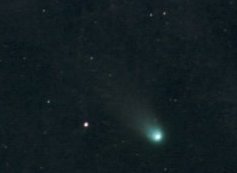
Hyakutake
Photo, 1996-Apr-05
More images of Hyakutake
Hyakutake was discovered in early morning of 1996-Jan-31 by Yuji Hyakutake.
It passed earth at 18 million miles distance on 1996-Mar-27. Speeding across the
celestrial sky at up to 16 deg/day it passed through Bootes Mar-21 to 24, past
Polaris Mar-25/26, between Camelopardalis and Cassiopeia Mar-27 to 30 and then into
Perseus where it began to slow Mar-31 to Apr-16 and then into Aries Apr-17 to
Apr-31.
I followed its path between 1996-Apr-01 and 1996-Apr-09.
I took some photos of Hyakutake by mounting my camera on top of my LX200 telescope and taking exposures of around 5 minutes duration.
Back to Top
Hale Bopp was the famous comet of 1997. Most people will remembering hearing about it, many will remember seeing it.
| Comet Hale Bopp 1997-Mar-27 Photos taken with Pentax Camera mounted on LX200, 400 ASA Film (More of my images of Hale Bopp) |
|
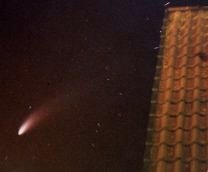 |
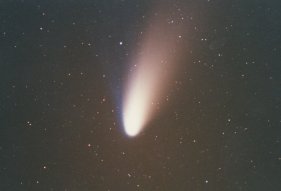 |
| 50mm lens, Exposure 5 mins | 300mm lens, Exposure 5 mins |
My first sight of Hale Bopp was in the year previous on 1996-Nov-07 when it lay close to the globular cluster M14 in the constellation of Ophichus in evening sky. At the time it was still fairly dim and without any discernable tail.
In 1997-Feb I observed it in the morning in the east (Cygnus). By March it had gone round the Sun and lay in the evening sky in the NNW, by which time it was a clear naked eye object with a well developed tail.
I made some observations of the comet on the evening of 1997-Mar-27 through my LX200 telescope, at which time the comet lay between the constellations of Cassiopeia and Andromeda. I also took some photos using Camera mounted onto of the LX200. These pictures came out pretty well. (see above and more images). The main dust tail (bright white-yellow white) was starting to become distinctly curved by this stage. A second tail (plasma tail) was also observable through the LX200 and from photos was blue in colour.
I continued making occasional visual observations of Hale Bopp through 1997-Apr and 1997-May until it disappeared from UK skies.
Back to Top
C/2000 WM1 (LINEAR) was imaged with a ST-7e camera though an 8" LX200 on
2001-11-01. (Images and more details at C/2000
WM1 Images, 2001-11-01)
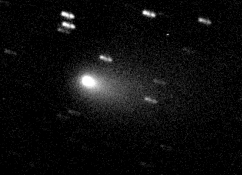
The following animated sequence of images was recorded on 2001-11-26:
| C/2000 WM1 (LINEAR) |
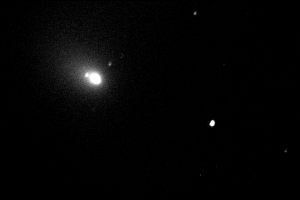
|
| 2001-11-26, 22:26 to 22:39h UT, Animation produced from 10 x 60s CCD images taken over a 13 minute period |
Better CCD images of C/2000 WM1 were recorded 2001-11-26 ( (Images and more details at C/2000 WM1 Images, 2001-11-26)
Back to Top
Images of C/2000 SV74 were recorded on 2001-12-14
Back to Top
C/2004 Q2 (Macholz) was the bright comet of 2004/2005 Winter
| Comet C/2004 Q2 (Machholz) motion (motion measured at 3.44 arc sec/hour) |
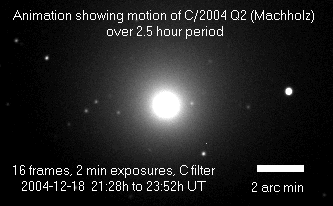
|
|
CCD Image Animation - aligned on comet 16 frames, 2 min exposure, C Filter 2004-12-18 21:28 h to 23:52h UT (#80045-110) (Animation with 66 frames was also created) |
| Comet C/2004 Q2 (Machholz) |
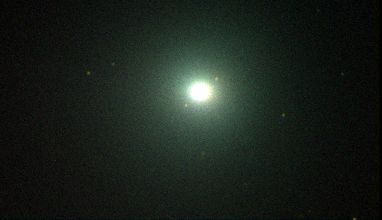
|
|
CCD Colour Composite Image Blue (av 2 x 90s B Filter, 100%), Green (30s V Filter,115%), Red (30s R Filter, 100%) 2005-01-05 23:43 h UT (#82121-24) |
Back to Top
|
Comet 73/P Schwassmann-Wachmann 3-B |
| Animated CCD frame sequence showing motion of Fragment B over a 26 minute period hrough Star Field on border between Hercules & Lyra. |
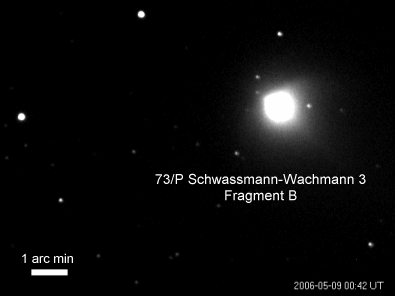 |
| CCD Image (75% size) 8 frames, 30s exposures, 1x1 binning, C Filter Linear Scale 2006-05-09 00:55h UT (#123203-37) |
| Fragment B | Fragment C | |
| Fragment B - 2005-04-26 | Fragment C - 2005-04-26 | |
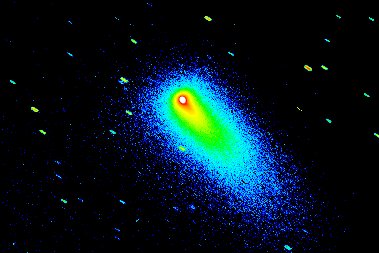
|
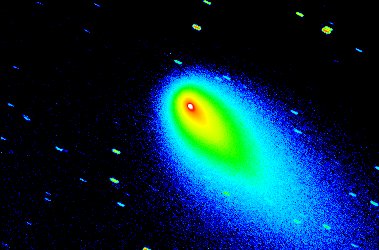
|
|
| Fragment B - 2005-04-27 | Fragment C - 2005-04-27 | |
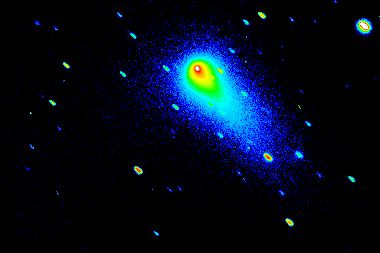
|
||
| Fragment B - 2005-04-28 | Fragment C - 2005-04-28 | |
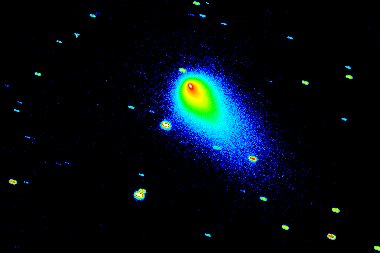
|
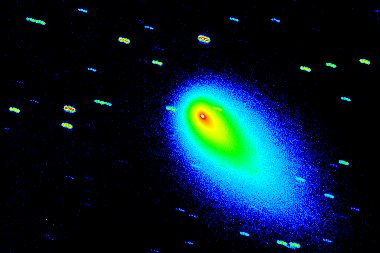
|
|
| Fragment B - 2005-04-29 | Fragment C - 2005-04-29 | |
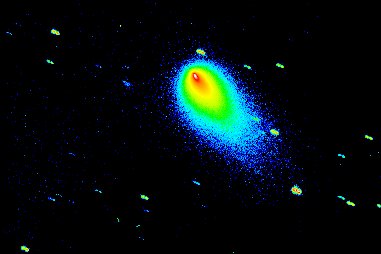
|
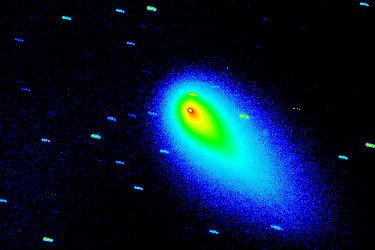
|
|
| Fragment B - 2005-05-03 | Fragment C - 2005-05-03 | |
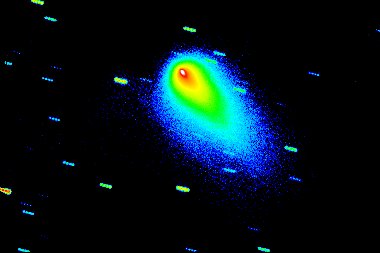
|
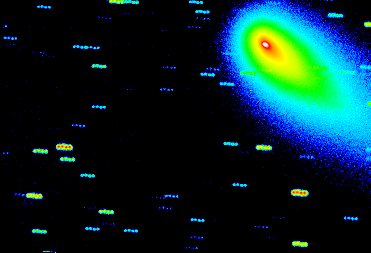
|
|
| Fragment B - 2005-05-05 | Fragment C - 2005-05-05 | |
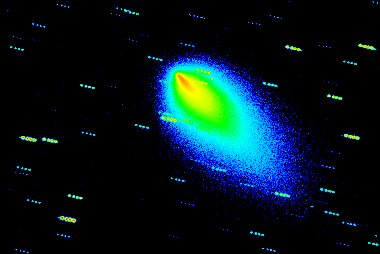
|
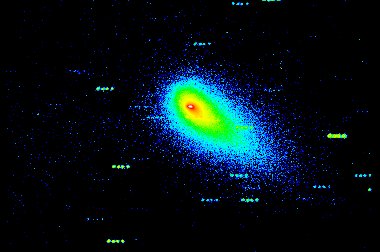
|
|
| Fragment B - 2005-05-08 | Fragment C - 2005-05-08 | |
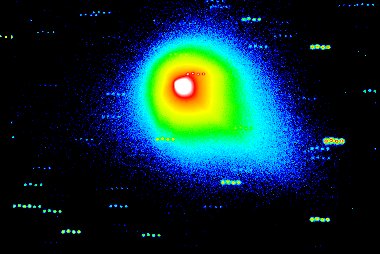
|
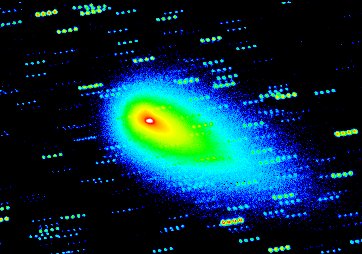
|
|
| Fragment B - 2005-05-09 | Fragment C - 2005-05-09 | |
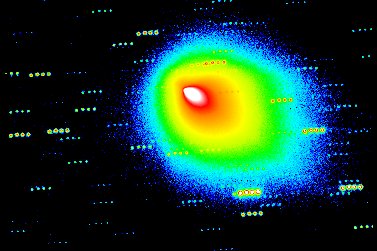
|
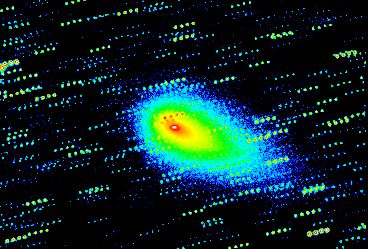
|
|
| Fragment B - 2005-05-10 | Fragment C - 2005-05-10 | |
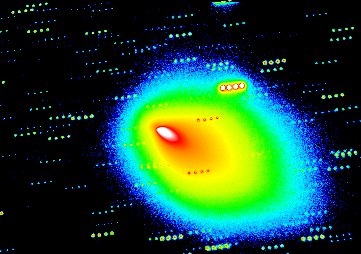
|
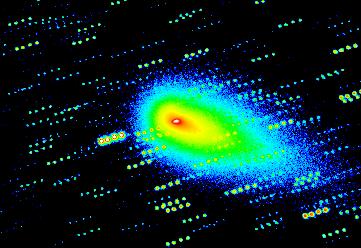
|
|
| Fragment B - 2005-05-12 | Fragment C - 2005-05-12 | |
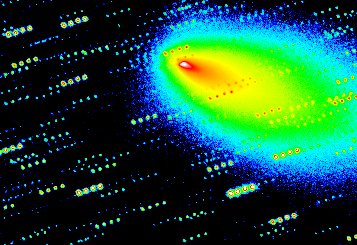
|
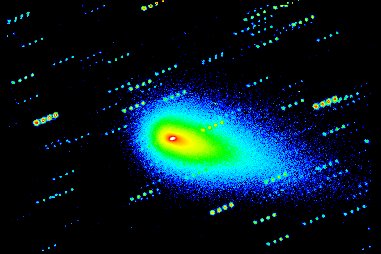
|
Back to Top
Meteors don't require any special equipment to view, just your eyes and some
knowledge about when and where to look. Meteor shower events, of which there are
a number throughout the year are the times when it is most likely that a meteor,
or shooting star can be seen.
One or two meteors are often seen during the course of a sky observing session, when not looking through the telescope's eyepiece. During particularly strong meteor showers up to around 100 meteors can be seen in a single hour if you're lucky.
I've recorded meteor shower observations for 3 events, Perseids 1995, Leonids 1998 and Leonids 1999.
Back to Top
1995-Aug-12, 23:00-23:35 UT. Observing from garden in Westhill, Aberdeen, saw 7 Perseid meteors in 35 minutes of observing (~14 meteors/hour). Included one particularly bright meteor which left a brief 'smoke' trail.
Back to Top
1998-Nov-16, 23:45-24:00 UT. Observing from garden in Westhill, Aberdeen saw 8 leonid meteors in 15-20 minutes of observing, including two excellent bright meteors which approached very fast from the east to end directly overhead, "close enough that you could see the sparks !" as my observing diary states.
1998-Nov-17, 05:20-05:50 UT. Drove to dark sight just beyond Westhill, Aberdeenwith full view of sky. Observed for 30 minutes during which time I saw around 80 Leonid meteors including a high proportion of fireballs (Mag -5 to -10). Peak rates where up to 4 or 5 meteors each minute (equivalent to 200-300 per hour). Meteors where all moving very fast. I had a fantastic view of them. Some of the fireballs were exceptionally bright, and momentarily lit up the sky and the ground, even when looking in completely the opposite direction The number of dim meteors were relatively few. It was clear to me that this was something exceptional and was some 11-12 hours ahead of the predicted peak. (due at 19:00 UT). Quite a few of the meteors where clearly a very long way in the distance, being low down near the horizon and only visable because of their exceptional fireball brightness. The brighter meteors had smoke trails, which lasted at least 2-3 minutes. Several of the meteors appeared to explode with faint projectile appearing to extend beyond the end of the bright ionization trail (see picture below). A thin crescent of the Old Moon was observable at dawn with very distinct earthshine.
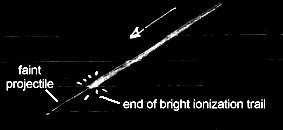
Leonid Fireball, emitting faint projectile
beyond 'explosion' point
Inverted from original sketch
1998-Nov-17, 23:45-24:00 UT. Observing from own garden in Westhill, Aberdeen I saw 4 leonid meteors in 15 minutes of observing (3 dim, only 1 bright).
1998-Nov-18, 05:00-05:30 UT. Drove to dark sight just beyond Westhill, Aberdeen with full view of sky. Observed for 30 minutes during which time I saw around 24 leonid meteors (c.50 per hour), nearly all of which were relatively dim - no fireballs - a distinct contrast to the previous morning, 1998-Nov-17.
Back to Top
1999-Nov-17, 03:40-04:15 UT. Saw no meteors in 32 minutes of net observing time. Limiting magnitude +4.0
1999-Nov-17, 05:35-05:40 UT. Saw one leonid meteor and one sporadic meteor in 5 minutes of observing. Limiting magnitude +3.5
Night of 1999-Nov-17/18 (the big night !) - unfortunately rather spoilt by shower clouds (snow) and cold temperatures. Total cloud at 1999-Nov-17, 23:00 UT and at 1999-Nov-18, 00:40 UT. Began observing at (1999-Nov-18) 02.10 for 3 minutes and then from 02:27 onwards to 04:30 UT with occasional breaks due to snow or passing cloud banks. Limiting Magnitude varying between +4.5 down to +1.0 or lower, cloud cover 20% - 80%+. Observed a total of 39 leonid meteors + 2 sporadics in 85 minutes of net observing time, rates where highest between 02:10 and 2:30 UT and then progressively dropped off. My data is consistent with a Leonid peak happening at or before 2:10 UT (internet reports talk about a peak at around 2.00 UT, ie close to the predicted peak). No fireballs were seen (compare with Leonids 1998), the brightest meteor was about magnitude -3.
| 1999-Nov-18, 02:10-02:30 UT | 10 leonids in | 6 minutes observing | (~100 meteors/hour) | |
| 1999-Nov-18, 02:30-03:00 UT | 16 leonids in | 24 minutes observing | (~ 40 meteors/hour) | |
| 1999-Nov-18, 03:00-03:30 UT | 8 leonids in | 27 minutes observing | (~ 19 meteors/hour) | |
| 1999-Nov-18, 03:30-04:00 UT | 1 leonid in | 5 minutes observing | (~ 12 meteors/hour) | |
| 1999-Nov-18, 04:00-04:30 UT | 4 leonids in | 25 minutes observing | (~ 9 meteors/hour) |
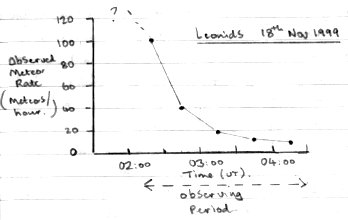
Leonid Apparent Rates - 1999-Nov-18
Back to Top
Viewed several geminid meteors on the evening of 1999-Dec-12 between 22:00 and
23:40 UT. Took several wide angle photos in an un successful attempt to capture
one of them on film.
(The Geminids peak around Dec-13/14 each year)
Back to Top
During a asteroid photograph hunt on 2000-Jan-03/04 (see Asteroid and Other Images 2000-Jan-03/04), I noticed several quadrantid meteors whilst watching the sky during photo exposures. 10 meteors were seen in the period 21:15 UT 3 Jan 00 and 00:40 UT 4 Jan 00, equivalent to a minimum of 3 meteors/hour. (limiting magnitude around 5)
On the following evening under similar observing conditions no meteors were seen during 2 hour period between 2000-Jan-04, 23:00 UT and 2000-Jan-05, 01:00 UT, placing some constraint on the timing of peak activity.
Back to Top
2000-Nov-17 . Generally cloudy. Saw 3 meteors before totally clouded over.
Back to Top
| This Web Page: | Comets & Meteors |
| Last Updated : | 2006-12-30 |
| Site Owner : | David Richards |
| Home Page : | David's Astronomy Web Site |